Understanding Avian Influenza: Symptoms, Diagnosis, and Prevention
Avian influenza, or bird flu, is a viral disease affecting birds' respiratory, digestive, and nervous systems. It presents in two forms - Highly Pathogenic Avian Influenza Virus (HPAIV) and Low Pathogenic Avian Influenza Virus (LPAIV). The virus has two important surface antigens, Hemagglutinin (H) and Neuraminidase (N). Clinical signs include soft-shelled eggs, respiratory distress, and increased mortality in flocks. Diagnosis involves isolating and identifying the virus, while prevention and control methods include strict quarantine measures and depopulating infected flocks. No specific treatment is available. Post-mortem lesions may include swelling and hemorrhage in various organs.
Download Presentation

Please find below an Image/Link to download the presentation.
The content on the website is provided AS IS for your information and personal use only. It may not be sold, licensed, or shared on other websites without obtaining consent from the author. Download presentation by click this link. If you encounter any issues during the download, it is possible that the publisher has removed the file from their server.
E N D
Presentation Transcript
1- Avian Influenza { Bird flu } Avian influenza is viral disease affecting respiratory, digestive and / or nervous system of many species of birds . Etiology Orthomyxovirus type A two forms :- 1- Highly Pathogenic Avian Influenza Virus {HPAIV} . 2- Low Pathogenic Avian Influenza Virus { LPAIV}.
O The virus have two types of surface antigens : The virus have two types of surface antigens :- - 1- Hemagglutinin (H) = 15 . 2- Neuraminidase (N) = 9 . O Incubation period : Few hours to days . O Course of the disease :- 1 2 weeks . Method of Spread : Method of Spread :- - 1- Contact . 2- Water fowl . 3- Slaughter house . 4- Live markets . O Morbidity : Variable . O Mortality: Can reach 80 100 % .
Clinical signs 1. Soft shelled eggs . 2. Sudden drop in egg production . 3. Cyanosis of wattles and comb . 4. Edema and swelling of head ,eyelids , comb ,wattles and hock . 5. Diarrhea . 6. Blood tinged discharge from nostrils . 7. Incoordination ,including loss of ability to walk and stand . 8. Pin point hemorrhages , most easily seen on feet and shanks . 9. Respiratory distress . 10. Increased death losses in a flock
Post mortem lesions: Swelling of the face and area below the beak . Clear straw colored fluid in the subcutaneous. Congestion in the skin and intestinal tract . Hemorrhage may be seen in the : 1. 2. 3. 4. a. Trachea . b. Proventriculus . c. Beneath the lining of the gizzard . d. Intestines . e. Muscles along the breast bone . f . Heart . g. Gizzard fat . H. Abdominal fat.
5. The lining of the gizzard may be easily removed. 6. Sinusitis with mucopurulent to caseous exudate . 7. Fibrinopurulent pericarditis . Note Note : : Young broilers may show signs of severe dehydration with other lesions less pronounced or absent entirely .
Diagnosis Isolation and identification of the virus . Serology : a. AGP { Agar Gel Precipitation test}. ELISA. HI {Hemagglutination Inhibition test }. 1. 2. A. B. C. ODifferential Diagnosis Differential Diagnosis Diseases affecting :- Respiratory , Digestive and Nervous systems .
OTreatment : Treatment :- - No treatment . O Prevention and Control : Prevention and Control :- - 1. Strict quarantine measures . Depopulate infected flocks . Bury infected birds . Killed vaccine are available for certain approved areas. 2. 3. 4.



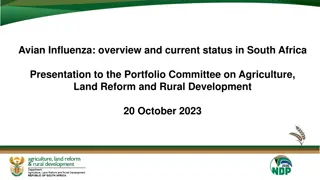
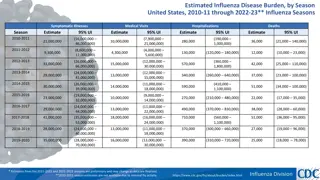
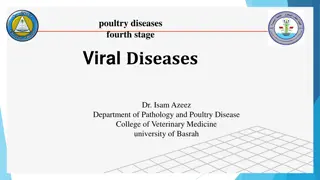

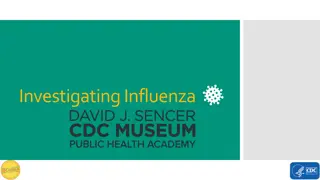
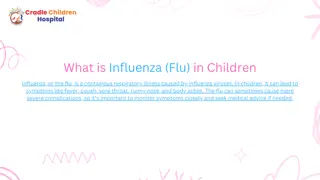

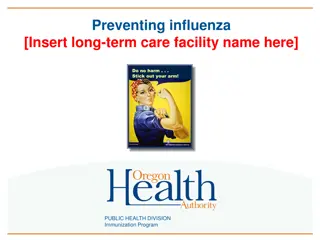
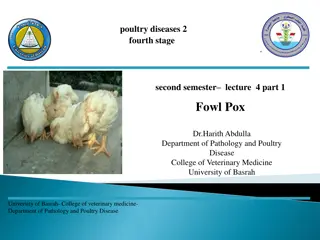
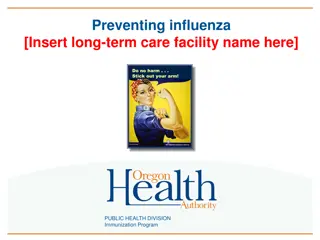



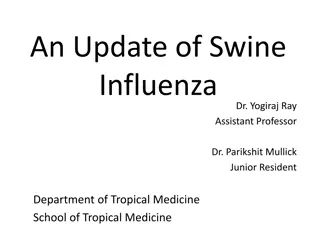
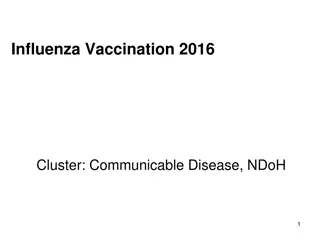
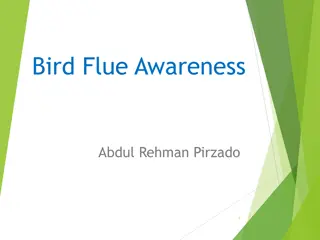

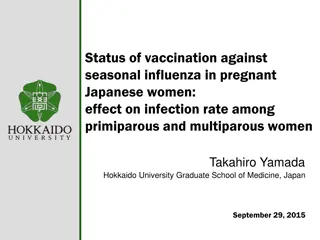

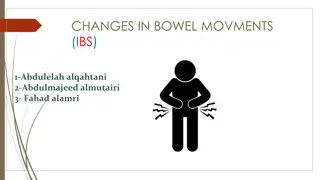
![Preventing Influenza at [Name of Critical Access Hospital]](/thumb/233818/preventing-influenza-at-name-of-critical-access-hospital.jpg)